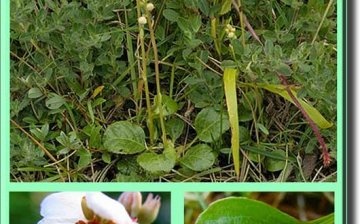The use of round-leaved wintergreen
Round-leaved wintergreen is a herbaceous perennial plant with a branchy long rhizome, a stem up to 30 cm high, with leathery leaves crowded at the stem, weakly odorous pink or white flowers and fruits similar to spherical capsules. He loves pine, pine-birch, oak, spruce forests, where moist soddy-podzolic soil is adjacent to lingonberries, blueberries, ochik, mine, acid, etc.
In order for it to be possible for large blanks, the plant must be cultivated, and for one's own needs a small amount of personal harvesting is enough.
For medicinal purposes, the aerial part of the round-leaved wintergreen is collected during flowering, its leaves contain: glycosides, essential oils, tannins, resins, mucus, gums, saponins, flavonoids, vitamin C and many trace elements (zinc, magnesium, barium, copper, etc. .). The plant has antiallergic, anti-inflammatory, diuretic, antitoxic and antitumor effects.
The use of round-leaved wintergreen in traditional medicine
- it is recommended to use the leaves of the plant for diuretic purposes, with a chronic inflammatory process in the bladder, prostate gland, with renal diseases and with dropsy;
- preparations containing a wintergreen are prescribed for an astringent, antiseptic and anti-inflammatory effect. They help with spastic phenomena and catarrh of the gastrointestinal tract, with inflammatory processes in the kidneys and bladder, with problems with the reproductive system (adnexitis, endometriosis, etc.). They are used for rheumatism and diabetes, to stop bleeding after childbirth.
The use of round-leaved wintergreen in alternative (folk) medicine
In alternative (folk) medicine, the whole plant is used. A decoction of wintergreen round-leaved is recommended to drink for diseases of the throat, for pain in the abdomen, it is prescribed in the form of lotions for ulcers and wounds on the skin. Winter tea is recommended to drink during the day for prevention, in order to combat harmful microorganisms in our body.



